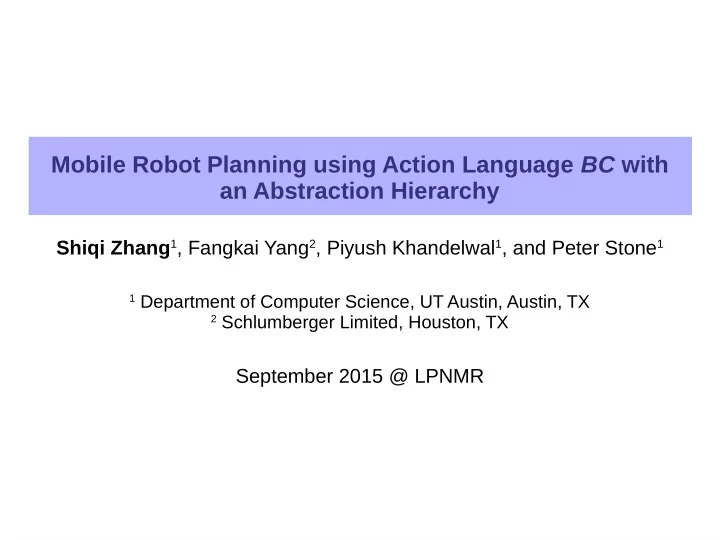

Mobile Robot Planning using Action Language BC with an Abstraction Hierarchy Shiqi Zhang 1 , Fangkai Yang 2 , Piyush Khandelwal 1 , and Peter Stone 1 1 Department of Computer Science, UT Austin, Austin, TX 2 Schlumberger Limited, Houston, TX September 2015 @ LPNMR
Overview ● Objective – Very efficient near-optimal symbolic planning for mobile robots ● Key features – Different abstraction levels of domain descriptions connected by passing state constraints downward – Not strictly following higher-level plans: better flexibility in computing low-cost plans at low levels 2
Action Language BC (Lee et al., 2013) ● Static law Example: ● Dynamic law Example: 3
Hierarchical domain representation ● Abstraction hierarchy – is a list of action descriptions such that for – is the step bound estimation function where computes the minimum number of steps needed to ensure that the effect of action can be optimally achieved at the next level 4
Example problem: mail collection ● formalizes if each person has been served or not ● further describes room connections through doors ● includes all domain details for primitive actions ● Planning initially at Level 3 would take too long ● The upper levels provide guidance on where to expand possible plans in Level 3 5
Action description: Level 1 ● Static laws: Recursively defined ● Dynamic laws: 6
Action description: Level 2 ● Static laws: ● Dynamic laws: 7
Action description: Level 3 ● Dynamic laws: ● Examples: 8
Hierarchical planning: passing state constraints downward ● Level 1: – Plan: – State constraints for the next level ( ): ● Level 2: – Plan: – State constraints for the next level: 10
Planning algorithms: PlanFG, PlanHL, and PlanHG ● State constraints generated at Level 2 ● PlanHG (global) considers ● PlanHL (local) considers all at the same time adjacent pairs 11
Two types of planning problems ● Type-I: short plan generation ● Type-II: low-cost plan generation 12
Experiments: short plan generation 13
Experiments: low-cost plan generation 14
Experiments: evaluating plan quality 15
Experiments: evaluating plan quality 16
An illustrative trial on a real robot (a) (b) (a) A Segway-based robot preparing to go through a door (b) Occupancy-grid map with a path planned for going through a door https://youtu.be/-QpFj7BbiRU 17
Related work Xiaoping Chen, Jianmin Ji, Jiehui Jiang, Guoqiang Jin, Feng Wang, and Jiongkun Xie. ● Developing High-Level Cognitive Functions For Service Robots, AAMAS, 2010 Jurgen Dix, Ugur Kuter, and Dana Nau. ● Planning in answer set programming using ordered task decomposition, Springer, 2003. Kutluhan Erol, James A. Hendler, and Dana S. Nau. ● HTN Planning: Complexity and Expressivity, AAAI, 1994. Piyush Khandelwal, Fangkai Yang, Matteo Leonetti, Vladimir Lifschitz, and Peter Stone. ● Planning in Action Language BC while Learning Action Costs for Mobile Robots, ICAPS, 2014 Craig A Knoblock. ● Automatically Generating Abstractions For Planning, AIJ 1994 Joohyung Lee, Vladimir Lifschitz, and Fangkai Yang. ● Action Language BC: A Preliminary Report, IJCAI 2013 Tran Cao Son and Jorge Lobo. ● Reasoning about policies using logic programs. In AAAI Spring Symposium on Answer Set Programming, 2001 18
Thank you 19
Recommend
More recommend